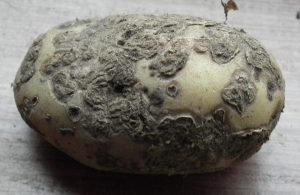Cause of, Identification of, Prevention of and Control of Potato Powdery Scab
Powdery scab is quite similar to common potato scab at first glance except that the scabs are more circular with a darker appearance giving a definite raised ring. These erupt, liberating pale brown spore masses and leaving loose skin edges to the lesions. In bad cases the tubers will be deformed by the disease.
Causes of Powdery Potato Scab
Although powdery potato scab looks similar to common scab, it’s caused by a slime mould, Spongospora subterranea, rather than a bacterium. Again in contrast to common scab, powdery scab is most common in wet seasons and on heavy, poorly drained soils.
The fungus can be resident in the soil or introduced by someone on their boots from an infected plot. It can also come in on a seed tuber or even in animal manure from stock fed on infected potatoes.
The mature scabs or galls release pinhead sized spore balls which stay in the soil until stimulated by the presence of potatoes. They then burst releasing zoospores which can swim short distances to infect the new crop.
Soil pH makes little difference to the disease.
How to Prevent & Control Powdery Potato Scab
There are no chemical controls available to the home grower however high levels of zinc in the soil can sometimes have a beneficial effect. Zinc rich fertilisers and zinc salt fertiliser additives can be purchased but detecting low levels of zinc in soil requires an expensive professional test which is not cost-effective for home growers.
Soil aeration prior to planting is helpful as is good drainage to avoid the tubers being too wet.
Dispose of infected tubers and peelings, which should not be home composted at low temperatures.
Long crop rotation where potatoes and other members of the solanaceae family such as tomatoes and peppers are not grown on the site for 6 years will reduce the fungal load in the soil but the spore balls have been shown to survive in the soil for longer than 13 years! Don’t forget that many weeds and ornamental plants are in the same family and can form a disease reservoir.
Avoid growing powdery scab susceptible varieties of potato, especially
|
|
|
Powdery Potato
Scab Resistant Varieties
|
|
|
Potato Growing Articles
- Growing Potatoes Overview – How to Grow Potatoes Guide
- How Many Seed Potatoes are Needed
- Potato Flowers, Fruits, Seeds & Breeding
- Growing Potatoes – Standard Traditional Method
- Growing Potatoes Under Straw Mulch
- Growing Potatoes Under Black Plastic (Polythene) Sheet
- Potato Growing in Raised Beds & Ridge Planting Potatoes
- Growing Potatoes in a Barrel – Patio Growing Potatoes
- Growing Potatoes in Bags | Greenhouse Potatoes
- Second Crop Autumn Planted Christmas New Potatoes
- Can you chit supermarket potatoes?
- Potato Varieties for Flavour -Boiled Baked Roasted Mashed
- Potato Fertiliser Program Program & (NPK) Requirements
- Potato Blight Cause, Identification. Prevention, Treatment Potato Blight
- Wireworm in Potatoes Cause Identification Prevention Control Potato Wireworm
- Eelworm Potato Cyst Nematode – Control Potato Eelworm
- Dry Rot in Potatoes Cause Identification Prevention Control of Potato Dry Rot
- Potato Scab – Common Scab in Potatoes
- Potato Scab – Powdery Scab in Potatoes
- Hollow Heart, Splitting & Spraing Potatoes
- White Spots on Potatoes Lenticels & Potato Stem Rot
See Also:
- Growing Potatoes for Show, Introduction & Best Varieties
- Growing Potatoes for Show, Cultivation of Show Potatoes
- Growing Potatoes for Show Harvest & Showing Potatoes




